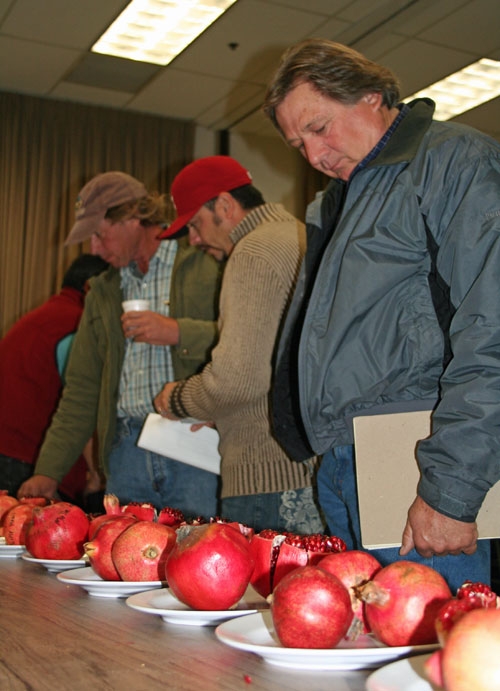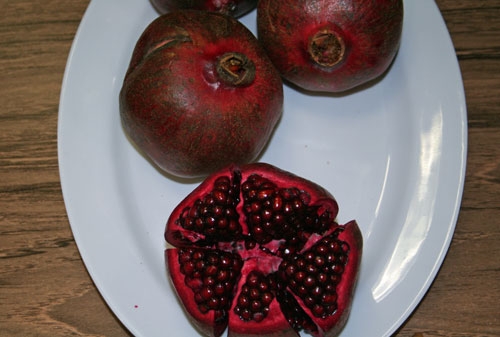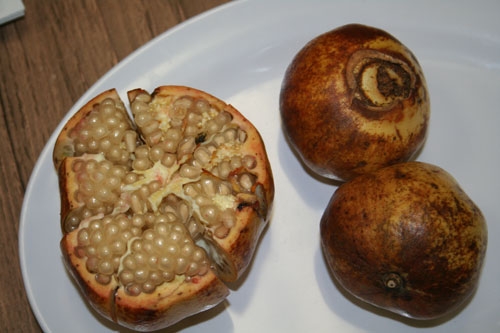Posts Tagged: Themis Michailides
KQED reporter visits the Kearney Agricultural Research and Extension Center

Alice Daniel, a reporter for the popular statewide public radio program The California Report, visited the Kearney Agricultural Research and Extension Center today to gather information for a story on aflatoxin. Daniel interviewed Kearney-based UC Davis plant pathologist Themis Michailides, who led the team that discovered how to expose pistachio trees to spores of beneficial fungus that displace the fungi that produce aflatoxin.
The fungus, AF-36, was used for the first time in pistachio orchards this past summer. For more on the story, read Pistachio farmers enlist a beneficial fungus to battle aflatoxin.
Daniel also recently interviewed Jeff Mitchell, UC Cooperative Extension specialist in the Department of Plant Sciences at UC Davis, for a story about farmers growing interest in conservation agriculture techniques. The story aired Sept. 4 and can still be heard on The California Report website.
The California Report airs locally at 6:50 a.m. and 7:50 a.m. Monday through Friday on Valley Public Radio, 89.3 FM in Fresno and is also available online.
Pistachio farmers enlist a beneficial fungus to battle aflatoxin

Aflatoxin can form on a wide variety of crops, from corn to cotton to tree nuts. Careful management practices help keep levels low, but still hundreds of thousands of pounds of pistachios are rejected each year due to the presence of aflatoxin.
UC Davis plant pathologist Themis Michailides and his team of researchers at Kearney discovered how to expose pistachio trees to the spores of a beneficial fungus that displaces the fungi that produce aflatoxin. Displacing aflatoxigenic fungi with a beneficial fungus has never before been done in tree crops.
“We’ve gotten great results,” Michailides said. “The reduction in aflatoxin contaminated nuts has been up to 45 percent. We anticipate higher reduction with application of the beneficial fungus for multiple years and on larger acreage.”
The new process was approved by the U.S. Environmental Protection Agency in February and the California Department of Pesticide Regulation in May, in time for 60,000 acres of the 2012 California pistachio crop to receive the innovative treatment.
“This is a big step,” Michailides said. “There will be a tremendous savings to pistachio growers by reducing rejections and the need for resorting nuts before going to market.”
Aflatoxin was discovered in the 1960s when a flock of turkeys in England died after eating contaminated feed. Aflatoxin is produced by certain strains of the fungus Aspergillus flavus, which is commonly found in soil and decaying vegetation. Aflatoxin is a resilient foe. Roasting nuts does not destroy the toxin. Other crops, such as corn and cottonseed used as animal feed, can be treated with ammonia to reduce aflatoxin, however ammonia treatment is not possible for human food, such as tree nut crops.
All shipments of pistachios are tested for aflatoxins, and are rejected in Europe if contamination exceeds 10 parts per billion and in the United States if shipments have more than 15 parts per billion.
The use of beneficial fungi to fight aflatoxin was first discovered and investigated by Peter Cotty, a USDA Agricultural Research Service plant pathologist located in the School of Plant Sciences at the University of Arizona. Cotty’s research focuses on reducing aflatoxin presence in corn and cottonseed. In collaboration with Cotty, Michailides and his colleague Mark Doster, staff research associate in the Michailides lab at Kearney, found that Aspergillus flavus 36 (AF36) can be introduced into an orchard by inoculating “dead” wheat seeds and then dispersing the seeds on the orchard floor. Dew and soil moisture spur the development of harmless spores that colonize pistachios and prevent colonization by toxigenic fungus strains.
The Kearney scientists are continuing their cooperation with USDA’s Cotty as they expand the research to almonds and figs.
“We’re conducting micro-plot experiments with the almond industry at Kearney,” Michailides. “We hope to get an experimental use permit soon to make the treatment available to almond growers.”
Michailides’ aflatoxin research was funded by USDA, the California Pistachio Research Board, the Almond Board of California and a UC Discovery Grant. The research was made possible by the involvement of cooperating pistachio growers who opened their orchards to scientists for conducting AF36 trials.
Pomegranates draw a crowd to Kearney

UC Integrated Pest Management Program entomologist Walt Bentley opened the meeting with an overview of the crop's most serious insect pests. Bentley suggested growers focus on omnivorous leaf rollers and cotton aphids. Ash whiteflies had been a pomegranate problem in the 1980s, until UC scientists introduced a natural enemy, encarsia, in 1991.
"This was an amazing biological control success," Bentley said.
Bentley admonished growers to protect the beneficial insects on their farms.
"Ash whitefly will eat you alive if you take encarsia away," he said.
Today, omnivorous leaf rollers are the key pomegranate pests. They move into the crop from weedy areas, feed on leaves, and unlike in grapes and peaches, will also feed inside pomegranate fruit.
"If you're not monitoring for it with pheromone traps you're going to get stung and it will cost you money," Bentley said. He suggested traps be placed in orchards in February.
Another important pest of pomegranates, cotton aphids, reduces crop yields and contaminates the fruit by excreting honeydew. Bentley described crop protection strategies for these pests plus ants, fork-tailed bush katydids, grape mealybug, false chinch bug, leaf-footed plant bug, citrus flat mite, navel orangeworm and filbert worm.
Kearney plant pathologist Themis Michailides presented research results from his lab on black heart disease of pomegranates. Black heart is of particular concern because it causes no external symptoms; consumers who encounter the unappealing blackened fruit inside may be reluctant to try pomegranates again in the future. The research focuses on the identification of the fungus species that cause black heart, understanding the infection process, and developing procedures to manage the disease. Michailides has concluded that the main cause of black heart is Alternaria spp., fungi that are very abundant in nature and cause diseases in many crops. Further research was conducted to determine when infections take place in order to properly time the management application.
"We found that the 'Achilles heel' for infection by Alternaria is the open pomegranate flowers," Michailides said. "Amazingly, infections start at bloom, remain latent in the fruit and develop later in season as the fruit matures."

Among Moersfelder's favorites are Parfianka, a well balanced, sweet-tart pomegranate with excellent grenadine flavor and soft seeds, and Ariana, which has deep red rind and dark red arils. The darkest variety in the Davis collection is Kara-Gul, a cultivar from Azerbaijian. This variety, however, is more susceptible to heart rot. Moersfelder also characterized spice type pomegranates from the Western Himalayas, which are dried and used as condiments in Indian food, and ornamental varieties, many of which produce beautiful flowers but no fruit.

The meeting was organized by UC Cooperative Extension farm advisors Maxwell Norton, Bob Beede, and Richard Molinar.